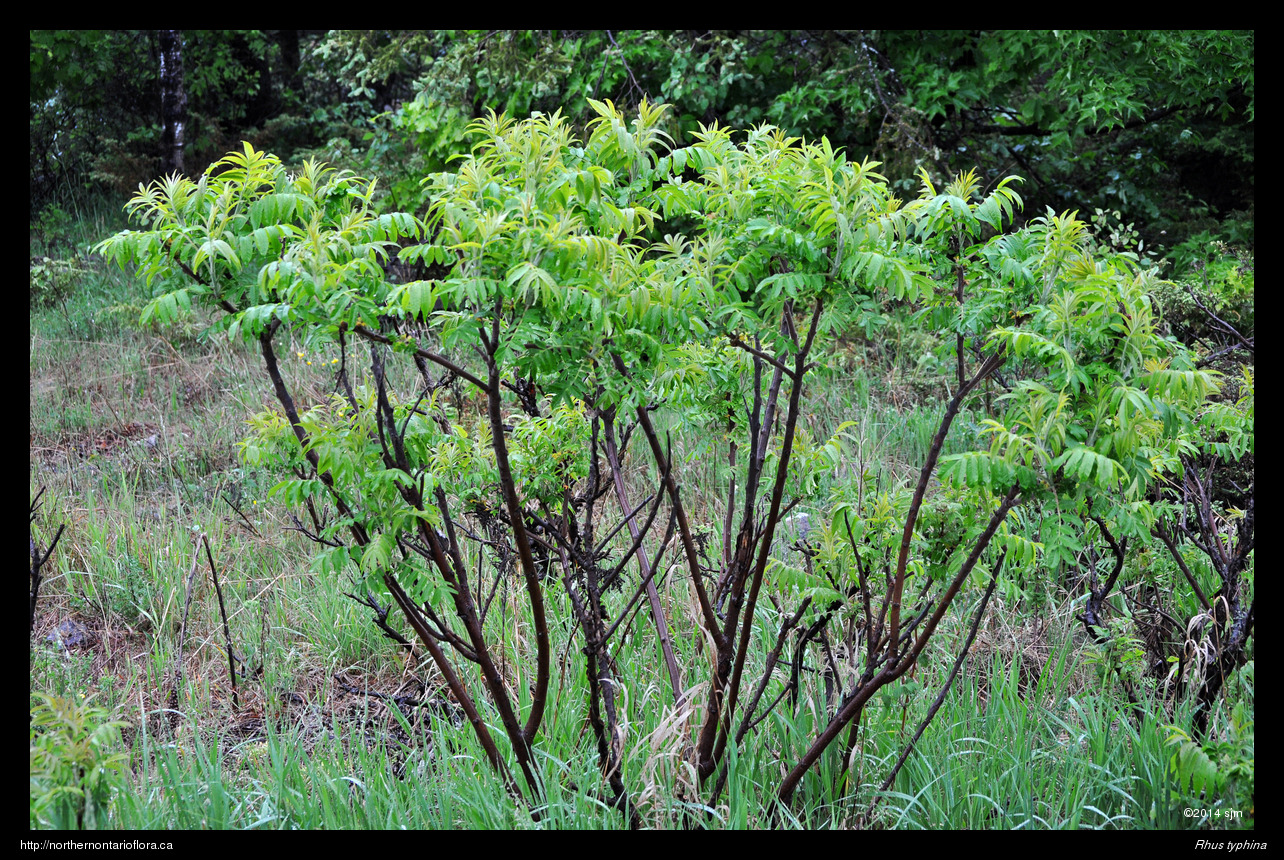
|
Northern Ontario Plant Database 
Plant DescriptionRhus typhina L. 1756, non Crantz 1766En: staghorn sumac, velvet sumac, vinegar tree
Anacardiaceae (Poison ivy Family) General: A thick-stemmed, open, deciduous shrub, 1—6 m tall, often forming thickets. Synonym: Rhus hirta (L.) Sudw. Stems/twigs: Twigs are stout, reddish-brown, and densely covered with short velvety light brown hairs. Young wood is greenish and the pith of mature stems is large and yellowish-orange; cut stems exude a milky sap. Terminal buds are absent, lateral buds are alternate, low, rounded, and covered with short dense pale brown to golden hairs. Leaf scars are large and somewhat elevated, C-shaped and nearly encircling the lateral buds, and have several small bundle scars scatted within the leaf scar. Leaves: Alternate, pinnately compound, 25—50 cm long with 11—31 (usually 13—15), leaflets; lateral leaflets are sessile, while the terminal leaflet is stalked. The rachis and long petiole are reddish and hairy. Leaflets are narrowly lanceolate or oblong, 7.5—13 cm long by 1—3 cm wide, smooth (glabrous) to slightly hairy above, and paler and hairy beneath. Leaflet bases are boradly tapering to rounded, apices taper gradually to long-pointed (acuminate) tips, and margins are sharply toothed (serrate). In autumn, the leaves turn yellow to orange and bright red. Flowers: Small and numerous, in elongate terminal branched inflorescences (panicles), 13—25 cm long, and showy, with both unisexual and bisexual flowers in the same panicle; flowering branches and flower stalks (pedicels) are hairy. Flowers have a 5-lobed calyx, 5 greenish-yellow petals, 5 stamens, and a single pistil with a superior ovary. Flowers bloom in late June to July. Fruit: In large clusters of small slightly flattened berry-like drupes. Each drupe, about 2—5 mm in diameter, is covered with short red bristly hairs. Fruits mature in late summer and persist over winter. Habitat and Range: Rocky or sandy soils of roadsides, open fields, slopes, clearings, and forest edges. Staghorn sumac is native to eastern North America. In the Algoma District, staghorn sumac occurs along the North Shore, on St. Joseph and Whitefish Islands, and around the Sault Ste. Marie area, as well as throughout eastern and southern Ontario. Similar Species: Smooth sumac (Rhus glabra L.) is similar to staghorn sumac, but can be easily distinguished by its smooth stems. Smooth sumac ranges farther north, to about the middle of the Algoma District. Fragrant sumac (Rhus aromatica Aiton) has bristly red fruit, like staghorn sumac, but its leaves resemble those of poison ivy. Fragrant sumac has leaves with only 3 ovate to obovate leaflets; the terminal leaflet is sessile and tapers to the base, while poison ivy leaves have a stalked terminal leaflet. Fragrant sumac grows on limestone bedrock, in basic soils, and on sand dunes in southern Ontario and Manitoulin Island, but is absent from the Algoma District. Back to species list |
||||||||||||||||||||||



























